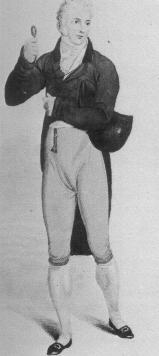what's next
Aug. 12th, 2013 05:42 pmI spent the week after coco doing laundry and recovering, then it was time for Irish Fair weekend. It was a blast and exhausting in a good way. I danced a lot and spent time with some of my favorite people.
But now that's over and I can think about sewing again!
The next thing I need to make is my man’s Regency suit. We have a Regency theme dinner in September. I thought I might make something for myself too but really now, I know there isn't time, so I plan to make do with my curtain dress – maybe a few fresh accessories can make it more 90s? I could pair the jacket with a muslin petticoat, full neckerchief, and a turban-ish headwrap. So definitely not Regency but a little closer to the idea.
I'm basically starting from scratch with the suit. First he needs a new shirt, which is easy. For the breeches I plan to use the J.P Ryan 18th century breeches pattern. It's early but the knee-length style remained in use for evening throughout the 18-teens, and I know it works. The vest I can enlarge from diagrams/make up. For the coat I might try the Laughing Moon pattern.
The biggest hurdle is making the fashionable ideal work with my husband's figure. The Regency fashion plate ideal is tall, skinny, almost grasshopper-like in its effect. He is stocky and broad-shouldered, with a full waist. The low waist of the 18th century is great for him, but the high waist of 1810 would just look silly.
Ex. This larger guy is totally making it work in 1770s dress. The vest ends well below the fullest part of the stomach.

But the up-to-the-armpits look of the early 1800s?

(Let's just ignore the camel toe for now.) This vest and coat end in the middle of the torso, putting the horizontal line at the fullest part of a larger man's stomach and increasing the width visually. Not to mention how to properly fit that on a larger man. With pants at that height, it would be hard to keep them up without some kind of suspenders. Until they get to the point where the torso starts to narrow again, there's nothing for the waistband to hold on to. Geometrically, It's like trying to belt a pair of pants to the bottom of an orange.
This caricature is kind of what I am talking about. The larger man's belt is sitting below the stomach, where most guys these days wear their jeans. The pants go up high and the short coat cuts him off unattractively at the midsection.

So what I need to find are portraits from the era (1805-15-ish) showing how larger men adapted the fashions to their bodies. Surely nobody wanted a portrait they paid for to look unflattering. And surely not all men had the grasshopper bodies of the Regency fashion drawings. I want to figure out how much I can alter the silhouette before it loses all the defining characteristics of the era.
But now that's over and I can think about sewing again!
The next thing I need to make is my man’s Regency suit. We have a Regency theme dinner in September. I thought I might make something for myself too but really now, I know there isn't time, so I plan to make do with my curtain dress – maybe a few fresh accessories can make it more 90s? I could pair the jacket with a muslin petticoat, full neckerchief, and a turban-ish headwrap. So definitely not Regency but a little closer to the idea.
I'm basically starting from scratch with the suit. First he needs a new shirt, which is easy. For the breeches I plan to use the J.P Ryan 18th century breeches pattern. It's early but the knee-length style remained in use for evening throughout the 18-teens, and I know it works. The vest I can enlarge from diagrams/make up. For the coat I might try the Laughing Moon pattern.
The biggest hurdle is making the fashionable ideal work with my husband's figure. The Regency fashion plate ideal is tall, skinny, almost grasshopper-like in its effect. He is stocky and broad-shouldered, with a full waist. The low waist of the 18th century is great for him, but the high waist of 1810 would just look silly.
Ex. This larger guy is totally making it work in 1770s dress. The vest ends well below the fullest part of the stomach.

But the up-to-the-armpits look of the early 1800s?

(Let's just ignore the camel toe for now.) This vest and coat end in the middle of the torso, putting the horizontal line at the fullest part of a larger man's stomach and increasing the width visually. Not to mention how to properly fit that on a larger man. With pants at that height, it would be hard to keep them up without some kind of suspenders. Until they get to the point where the torso starts to narrow again, there's nothing for the waistband to hold on to. Geometrically, It's like trying to belt a pair of pants to the bottom of an orange.
This caricature is kind of what I am talking about. The larger man's belt is sitting below the stomach, where most guys these days wear their jeans. The pants go up high and the short coat cuts him off unattractively at the midsection.

So what I need to find are portraits from the era (1805-15-ish) showing how larger men adapted the fashions to their bodies. Surely nobody wanted a portrait they paid for to look unflattering. And surely not all men had the grasshopper bodies of the Regency fashion drawings. I want to figure out how much I can alter the silhouette before it loses all the defining characteristics of the era.